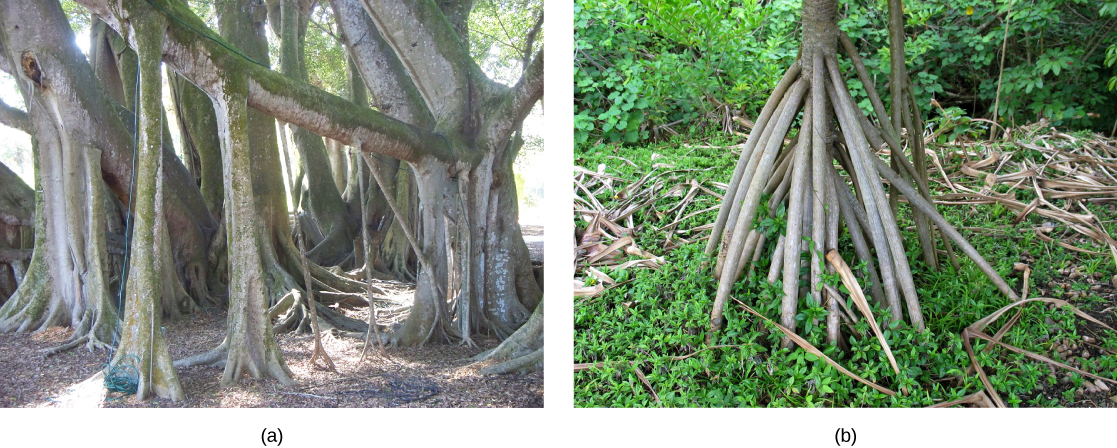3.2.4: Root Modifications
- Page ID
- 37034
Learning Objective
Describe the types of modified roots and their functions.
Root structures may be modified for specific purposes. For example, some roots are bulbous and store starch. Tap roots in plants such as carrots, turnips, and beets, are examples of roots that are modified for food storage (Figure \(\PageIndex{1}\)).

Aerial roots are forms of aboveground roots that provide additional support to anchor the plant. Epiphytic roots are a type of aerial root that enable a plant to grow on another plant. For example, the epiphytic roots of orchids develop a spongy tissue to absorb moisture. The banyan tree (Ficus sp.) begins as an epiphyte, germinating in the branches of a host tree. The plant's aerial roots develop from the branches and eventually reach the ground, providing additional support (Figure \(\PageIndex{2}\)). In screwpine (Pandanus sp.), a palm-like tree that grows in sandy tropical soils. Plants which grow on sand have another problem: their substrate constantly disappears. To avoid this, plants developed contractile roots which may shorten and pull plant body deeper into the sand.

Plants growing in ocean coastal swamps need additional specializations. Roots of mangroves are frequently modified into supportive aerial roots called stilt roots. Stilt roots are adventitious and grow from lateral branches. Swamp plants are often flooded and need additional adaptations for respiration. Pneumatophores are specialized roots that grow upward and allow oxygen and carbon dioxide exchange from the plant's root system. They passively catch the air via multiple pores (Figure \(\PageIndex{3}\)).

Some aerial roots will function as photosynthetic organs as well. Though rare, you can see green photosynthetic roots in some plants such as epiphytic orchids (Figure \(\PageIndex{4}\)). In some cases, the plant is leaf-less so all the photosynthesis is done by the aerial roots. In other plants, the aerial roots aid in photosynthesis.

Root nodules present on the roots of nitrogen-fixing plants, they contain bacteria capable to deoxidize atmospheric nitrogen into ammonia: N\(_2\) \(\rightarrow\) NH\(_3\). Root nodules contain also hemoglobin-like proteins which facilitate nitrogen fixation by keeping oxygen concentration low. Nitrogen-fixing plants are especially frequent among faboid rosids: legumes (Leguminosae family) and many other genera (like alder, Alnus, or Shepherdia, buffaloberry) have root nodules with bacteria. Some other plants (mosquito fern, Azolla and dinosaur plant, Gunnera) employ cyanobacteria for the same purpose.
Mycorrhiza is a root modification started when fungus penetrates root and makes it more efficient in mineral and water absorption: it will exchange these for organic compounds. In addition to mycorrhizal fungi, endophytic fungi inhabit other plant organs and tissues.
Attributions
Curated and authored by Kammy Algiers using 30.3 Roots from Biology 2e by OpenStax (licensed CC-BY). Access for free at openstax.org.


